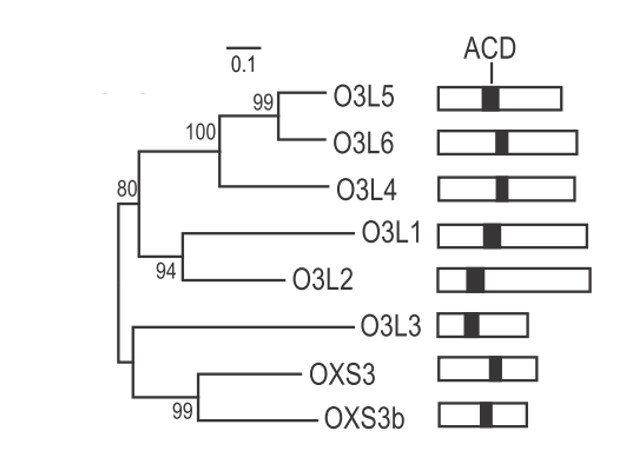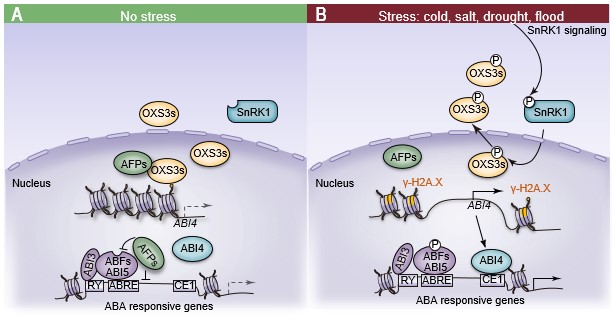

Previously, Dr. David W. Ow’ s group in South China Botanical Garden found that overexpression of Arabidopsis OXS3 (OXIDATIVE STRESS 3) or OXS3-like cDNAs in Schizosaccharomyces pombe enhances tolerance to heavy metals or oxidizing chemicals, and they speculated that the OXS proteins could play crucial roles in stress tolerance in plants. When the research group examined the stress sensitivity of the Arabidopsis mutants of the OXS gene family, an ABA (Abscisic acid)-sensitive phenotype was found (Figure 1 and 2).
ABA signaling is important for Arabidopsis adaptation to environmental changes. For example, when Arabidopsis faces with adverse environmental conditions, seedlings can employ the strategy of invoking a stress-induced growth arrest response mediated by ABA, to wait for favorable growth conditions. Therefore, Dr. Ow’s group tried to characterize the roles of OXS gene family members in ABA signaling and to unravel the mechanism of ABA mediating responses for the stress tolerances in plants. The protein-protein interaction analysis and the kinase assay suggested that ABA-responsive SnRK1 (SNF1-related protein kinase 1) could phosphorylate OXS3s, and then promoted the trans-location of OXSs from the nucleus to the cytoplasm. The yeast two hybrid assays showed that five of OXS3 proteins and seven OXS3 family members interacted with AFP1 (ABI FIVE BINDING PROTEIN 1) and with histone H2A.X, respectively. The ChIP-qPCR data indicated that the absence of some of the OXS3 proteins was associated with increased occupancy of histone γ-H2A.X at the ABI4 (ABA INSENSITIVE 4) promoter, which was also corresponded with de-repression of ABI4 expression. In conclusion, these results implicate a working model as follows. In the absence of stress, the OXS3s interact with AFP1 to repress the ABI4 promoter and decrease γ-H2A.X occupancy, which leads to the repression of ABI4 expression. Furthermore, AFPs can promote ABI5 degradation and may interact with chromatin modifiers to repress the transcription of ABA-responsive genes, resulting in the inhibition of ABA signaling (Figure 3A). During stress, the ABA-responsive SnRK1 can phosphorylate the OXS3s and cause the export of OXS3s from the nucleus. The absence of nuclear OXS3s increases of γ-H2A.X occupancy and relieves repression of ABI4, and then the ABA-responsive genes are finally activated (Figure 3B).
This study has been conducted by Dr. Shimin Xiao (First author), Dr. Chuanghu Wang (co-corresponding author), Dr. David W. Ow (co-corresponding author) and their colleagues. The relevant articles entitled “Arabidopsis OXS3 family proteins repress ABA signaling through interactions with AFP1 in the regulation of ABI4 expression” and “SnRK1 regulates chromatin-associated OXS3 family proteins localization through phosphorylation in Arabidopsis thaliana” have been published in “Journal of Experimental Botany (2021), erab237 (IF: 6.99)” and“Biochemical and Biophysical Research Communications (2020), 533: 526-532 (IF: 3.58)”, respectively. This work received the funding supported by the “National Key Research and Development Project (Grant No. 2016YFD0101904)” from the “Ministry of Science and Technology of China”, and by the “Key Research Program of Frontier Sciences, Chinese Academy of Sciences (Grant No. QYZDY-SSW-SMC010)”.
Link: https://doi.org/10.1093/jxb/erab237
https://doi.org/10.1016/j.bbrc.2020.08.108

Figure 1. OXS3 phylogenetic family tree by MEGA 6 with neighbor-joining method, bootstrap = 1000. Scale bar represents 0.1 aa substitutions per site. Black box indicates putative N-acetyltransferase catalytic domain (ACD).

Figure 2. Seedlings of Quad1 (oxs3-2 oxs3b-1 o3l4-1 o3l6-1) quadruple mutant are more sensitive to ABA. Seedlings of Quad1 and WT Col-0 7 d after germination (~40 seeds) on 0.5 MS plates. Scale bar=1 cm.

Figure 3. Model of ABI4 regulation by OXS3 family proteins.

